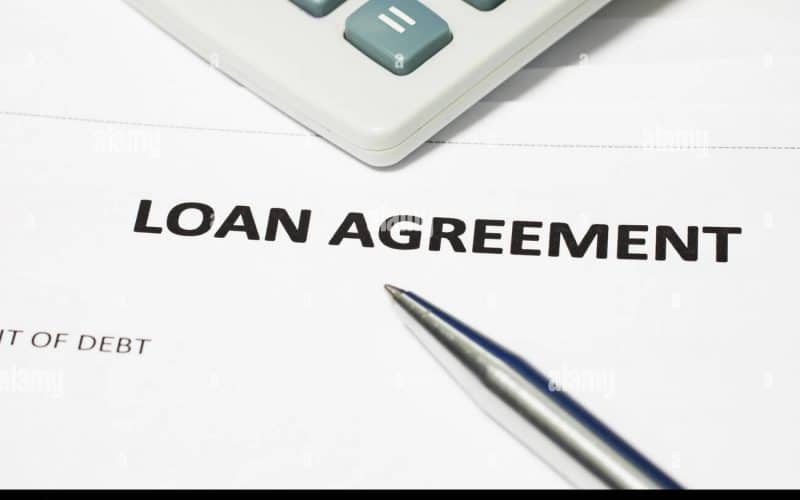Borrowing money is a necessary part of life for most individuals. Also, Borrowing money is something nearly everyone does at some point in their lives, whether it’s to fund a major purchase like a car or home, fund a higher education, or deal with an emergency medical bill. Loans and the contracts that guarantee them are practically everywhere. A personal loan agreement is a legally enforceable contract between a lender and a borrower. Promissory notes between friends and family members are the most basic form of a loan agreement, but mortgages, automobile loans, credit card agreements, and payday advance loans, both short- and long-term, also exist. In this article, we will discuss loan agreement format, template, and forms.
What is Loan Agreement?
A loan agreement is a legally binding instrument that can provide protection for the parties concerned. Most often, it is the lender that drafts the loan agreement, making them responsible for making sure all necessary provisions are included. If this is your first time drafting a loan agreement, you should familiarize yourself with all of the parts to ensure that you don’t leave out any provisions that could be useful to you later.
Furthermore, even if the loan is for a significant amount of money, a simple and friendly loan agreement might take the form of a letter outlining the repayment schedule and any additional interest that may be charged. Some are simple handshake agreements, while others, like mortgages, are complex legal instruments that are recorded in a public database and provide lenders the right to take back collateral if a borrower defaults on a loan.
The terms and circumstances of each loan agreement are subject to state and federal regulations aimed at preventing illegal or exorbitant interest rates from being charged.
The length during which a loan must be repaid, the interest rate terms, the interest rate itself, any guarantees made, and any covenants included, are all standard components of any loan arrangement. Deficiencies in clarity regarding default terms can lead to litigation. All charges associated with recovering the debt owed should be spelled out in the event of a default. In addition, Promissory note users fall under this same category.
What Are the Types of a Loan Agreement?
Here are a few types of loan agreements:
#1. Loans for Individuals
If we run into operating cash flow issues, you may decide to negotiate a personal loan agreement. The borrowed funds may be used for everything from debt reduction to emergency medical care to home improvement to a vacation. In order to determine whether or not to extend credit, private banks look at a borrower’s credit history and financial transactions with the creditor.
#2. Loan for a House
Homeowner tax credits can be put toward the purchase of an existing home, the construction of a new one, or the renovation of an older building, as well as the purchase of land on which to construct homes. In such a scenario, the creditor would keep the asset, and the homeowner would give the creditor control of it.
#3. With Regard to a Guarantee
In exchange for these payments, the client is required to provide some form of security for the mortgage. However, in the event that the lender is unable to refund the money, the organization will still have the authority to pursue the missed charge using the security that was promised. In most cases, borrowing on such mortgages comes with a lower interest rate than borrowing money elsewhere.
#4. Loans with No Security
These are the types of loans that do not require any form of collateral. The financial institution will consider the lender’s previous connections, current debt levels, and any other relevant variables while deciding whether or not to grant the credit. Because there are no means to collect the entirety of the loan agreement in the event that the debtor defaults, the cost of borrowing money for these mortgages could be higher.
#5. Depending on the Purpose of the Education Loan
Investment banks that work with borrowers to assist them in completing their education are called education loan agreement providers. A recognized organization’s associate’s degree program, professional certification, or any scholarship course can serve as the basis for this study. Students will need the bank’s approval to enter the building in order to be eligible for financing. In addition, money is provided by banks for both internal and external research projects.
How Do I Write a Loan Agreement?
When you lend a friend a few dollars for lunch, you probably won’t feel the need to write out any kind of legal agreement because it’s just a small amount. If, on the other hand, you intend to give your friend a more considerable loan — for example, to start a business, pay off a debt, or make a down payment on a car or house – it is imperative that you put your arrangement in writing. If you treat the loan as if it were a business transaction rather than a simple favor, there is a better chance that your friend will actually pay you back, and the arrangement will be more likely to be upheld in court if there are any issues. Here are tips on how to write a loan agreement.
#1. Gather in Person
Avoid relying on a phone discussion to negotiate the loan with your friend; if at all possible, you should meet with them in person.
Meeting face-to-face allows you to pick up on subtle cues about each other’s emotions and level of seriousness while you negotiate the terms of the loan. If your friend lives far away or if you can’t meet in person for any other reason, it’s best to work out the details via email rather than over the phone so that both parties can refer back to the email thread later. Take notes during your meeting with your friend so you can refer to them while crafting the agreement.
#2. Talk About the Company’s Budget and Needs
Make sure you fully grasp the financial situation and motivations before agreeing to lend money.
To help you better understand their financial status and potential options, they should bring any pertinent documents or information with them.
Investigate whether they have tried approaching conventional lending providers like banks for a similar loan. If that’s the case, you should inquire as to the nature of the offer and the circumstances surrounding it. You might wonder why you should finance them if no banks are interested in doing so.
Furthermore, no matter the amount of the loan, from $500 to $50,000, honesty is required between individuals who are engaging in such a financial transaction. The process can be made more objective and less personal by inquiring about the individual’s financial situation and the reason for the loan. Think about how much you’re willing to lend and how much it would hurt if they didn’t pay you back. In addition, you shouldn’t put in extra effort just to please them.
#3. The Interest Rate Should Be Established
Depending on the size of the loan, you could face tax penalties if you choose not to charge interest. You must charge interest, collect interest, and have a written loan agreement in order to convince the IRS that the money is a loan and not a gift. If you don’t charge interest, the IRS may consider the interest money a gift to your friend. In addition, there may be a gift tax on this sum.
Also, rates can be as low as the federal minimum. As of October 2015, the minimum rate for loans with a repayment term of fewer than three years is 0.55 percent. You shouldn’t offer a high-interest rate generally, but if you want to charge more than 10%, check your state’s regulations. Usury regulations in most states cap the amount of interest a lender can charge their customers. It can be as low as 7% in areas like Michigan but is more common in the 10% – 20% range.
Furthermore, don’t forget that you can earn interest on the money you lend your friend if you put it in a savings account or CD for the same time period. If you don’t charge interest on the loan, you lose money even if the borrower pays it back.
#4. Set up a Plan for Paying It Back
The two parties can work out a manageable payment plan without putting undue stress on each other’s finances if you take the time to learn as much as possible about your financial condition. Help them create a budget to minimize expenditures and pay off the loan if they have financial problems.
Also, many loans between parties, for instance, call for nothing more than a single, future lump sum payment covering the entire principal plus interest. Payments might be spread out over a certain number of weeks, months, or years, or they can start off little and build up to a larger “balloon” payment at the conclusion of the repayment period.
#5. Fix Any Other Problems or Circumstances That May Arise
Before signing the agreement, you and your friend should anticipate loan issues and find a solution. Let’s say, for argument’s sake, that the individual has five years to repay the debt. For two years, they have been paying on schedule, but now you have an emergency and need the money right away. In the event that they are unable to repay the debt in full, you may wish to include a provision that allows you to “sell” the obligation to a third party. You may then borrow the required sum and pay it back with the money you receive.
You probably wouldn’t care who was making the payments as long as payments were being made, but this should be made clear in your agreement. A monthly or quarterly meeting to discuss the loan and ensure everything is on track keeps communication open. The terms of such an agreement should be recorded in writing. If the borrower has a history of financial issues, include a bankruptcy clause in your agreement.
What does a Loan Agreement include?
Here are what is included in a loan agreement:
#1. Location
In most cases, the Loan Agreement will be executed at the lender’s location, but if the loan is being used to acquire assets, the parties may agree to change the site of the agreement to where the assets are located.
Also, loan Agreements are governed by distinct statutes in every jurisdiction. The laws of your state will apply to enforcing this Agreement and resolving any issues.
#2. Insurance and Collateral
Borrowers can put up collateral to secure loans (e.g., a valuable item such as a vehicle, piece of equipment, or jewelry). When a borrower defaults on a loan, the lender may seize the collateral to recoup losses.
If you plan on using your loan to purchase a vehicle, your lender may insist that you have car insurance as well.
#3. Information About the Lender and the Borrower
Identify the parties, whether they are persons or businesses, and provide their contact information. If the borrower cannot repay the loan, a co-signer can step in and promise to do so.
#4. The Date and Amount of the Loan
The loan amount also called the principal amount, is the total amount of money that the lender agrees to lend to the borrower. Provide the date that the borrower will receive the principal amount.
Personal Loan Agreement
A personal loan agreement specifies the terms and conditions of the loan between the lender and borrower. It specifies the loan amount and the terms under which it must be repaid.
This arrangement sometimes called a “personal loan agreement,” serves to safeguard the individuals involved in the event of a dispute or disagreement. Financial institutions typically require borrowers to sign such an agreement before disbursing any funds, but borrowers may also consider drawing out a personal loan contract before loaning money to close friends and family.
What Is a Personal Loan Agreement?
A personal loan agreement is a legally enforceable contract that can be set up with a formal lender such as a bank or credit union, or with a more informal lender such as a friend who is lending you money. Overall, it says (among other things):
- The total amount of your loan
- If you say you’ll pay it back, that’s a promise.
- Anything you’ve agreed to pay—a fee or penalty (such as if you prepay the debt or become delinquent)
Furthermore, A lender can seek legal action to recover default loan funds through wage garnishment or other means.
Personal loans often are unsecured, meaning the lender is taking you at your word without any other kind of security. A secured personal loan contract requires you to pledge an asset, such as a vehicle or a home, as security for the loan. Your collateral is at risk if you don’t pay back the loan. In addition, please read that part of the contract carefully.
To avoid misunderstandings and straining your relationship, loan money to a family member or close friend in writing. Inconvenient as documentation may be for smaller personal loans that may be paid off with the next paycheck, it may be necessary for larger personal loans that will take longer to repay.
How Do You Write a Personal Loan Agreement?
A Personal loan agreement from a financial organization is based on the template; if you borrow money from an individual, you will need to create your own.
Your decision to retain legal counsel depends on the specifics of your case, so take some time to think it over. DIY methods, however, are fully legitimate and enforceable under the law. After you and the lender have reached an agreement on the terms of a personal loan, you may wish to have the document notarized or have a third party present to act as a witness.
It’s smart to get everyone on the same page so that you can nail down the fundamentals and come up with a backup plan, just in case.
Where Can You Find a Template Personal Loan Agreement?
A Personal loan agreement template can be found easily online, and for little to no cost. Although not every personal loan agreement template will be useful for your needs, it can serve as a starting point for creativity.
What Are the Four Parts of an Agreement?
To be binding and enforceable under the law, a contract needs only a few standard characteristics, regardless of how many pages it may be or how much information it may contain. Agreements, whether verbal or written, must be mutually agreed upon, confined to acceptable aims, and between reasonable persons. In the absence of certain mandatory provisions, an agreement will be deemed null and void. Here are the four parts of an agreement.
#1. Similar Opinion
For a contract to be legally binding, both parties must agree to its terms. The agreement, or “mutual assent,” means that all parties to a transaction are in agreement with one another. After reaching an agreement, one party makes an offer, and the other party accepts it under the agreed-upon circumstances. In common parlance, the “meeting of the minds” refers to the exchange of “offer” and “acceptance.”
#2. Legality
Agreements are enforceable only if they are used for lawful purposes. The law does not recognize or uphold contracts that encourage or require the commission of a crime. Because the applicable laws vary from one location to the next, the jurisdiction clause of an agreement is crucial.
#3. Consideration
For an agreement to be legally binding, it must provide one type of compensation in exchange for another. The thing of value being exchanged between the parties to an agreement is called “consideration.” The value and scope of the compensation can vary widely. Property, goods, and services are all common types of consideration.
#4. Capacity
Having the ability to carry out one’s contractual duties is a necessary condition for a contract to be enforceable. In most cases, a minor lacks the legal maturity to enter into legally binding contracts. Each party must be of legal age and in sound mind in order to sign the agreement.
What is the Purpose of a Loan Agreement
A loan contract’s primary function is to set down the terms and conditions of the loan, including the obligations of each party and the duration of the agreement. Each party to a loan agreement deserves the protection afforded by state and federal laws in the event that a borrower or lender defaults on their obligations under the terms of the agreement. Both parties must comply with the loan agreement and state or federal laws depending on the loan type.
The usage of the money is usually spelled out in detail in the loan agreement. When it comes to legality, there is no differentiation between, say, a mortgage loan and an auto loan, or between a loan used to pay off existing debt and a new loan used to consolidate credit card debt. The loan agreement confirms the borrower and lender’s agreement on funds use, repayment, and interest rate. If the borrowed funds are not used as agreed upon, they must be promptly repaid to the lender.
Conclusion
A loan is borrowed funds that are expected to be repaid within a specified time frame. If the buyer does not make loan repayments as promised, the loan agreement will go into effect to enforce repayment. An agreement that has been signed by both parties is legally binding. In order to avoid potential legal complications and misunderstandings, each party should review the loan agreement template as a whole before signing. Any loan agreement, whether it be with a bank or another financial organization, will define the conditions, rights, and obligations of the borrower. However, the requirements for the loan agreement components may change based on the type of loan agreement being drafted.
Loan Agreement FAQs
What is the use of the loan agreement form?
You can alter the loan agreement template from legal depot to suit your needs, such as:
- There are firm loans available, such as startup capital.
- Investments in a car, a yacht, or new furniture.
- Mortgages, construction loans, land purchase loans, etc.
- Student loans cover tuition and other educational expenditures.
- For debts or bills, friends or family lend to each other.
Is the loan agreement legally enforceable?
Loan agreements are beneficial to both parties both the borrower and the lender for a number of reasons. Particularly, this legally binding agreement protects the rights of both parties in the event of a breach by one party. A loan agreement ensures that the lender will be paid back in full and on schedule from their perspective.
Similar Posts
- Can You Use a Personal Loan to Start a Business? What You Should Do
- Paypal Transaction Fees: What are The Transaction and How to Avoid The Unnecessary Fees
- HOW to DO BUSINESS LOANS WORK: What It Is and How It Works
- ONLINE LOANS: BEST OPTION TO LOOK OUT FOR (+ HOW TO APPLY GUIDE)
- WHAT IS REFINANCING: Meaning, How It Works & Purpose






